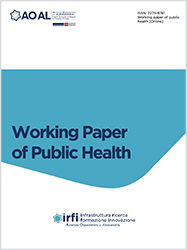Dal Pronto Soccorso al Reparto di degenza: gestione dei pazienti con scompenso cardiaco a FE ridotta
All claims expressed in this article are solely those of the authors and do not necessarily represent those of their affiliated organizations, or those of the publisher, the editors and the reviewers. Any product that may be evaluated in this article or claim that may be made by its manufacturer is not guaranteed or endorsed by the publisher.
Autori
Obiettivi: endpoint primari - valutare la mortalità cardiovascolare e per tutte le cause nel primo anno in pazienti anziani arruolati con Angiotensin Receptor Inhibitor (ARNI) e/o Sodium Glucose Co-Transporter Type 2 Inhibitors (SGLT2-i) in un reparto internistico; valutare il ricovero ricorrente per Heart Failure with Reduced Ejection Fraction (HFrEF) acuto; analizzare la durata del ricovero confrontandola con i non arruolati. Endpoint secondari: identificare i parametri predittori della durata della ospedalizzazione; definire la sicurezza tramite l’incidenza di complicanze e di interruzione del trattamento. Materiali e Metodi: studio real-life prospettico osservazionale di coorte che analizza l’arruolamento durante il ricovero ed il followup 3-16-12 mesi dopo la dimissione. Sono stati registrati molteplici parametri per ogni paziente di diversa etnia, valutando la diagnosi di HFrEF acuto con NT-proBNP e RX-torace. Risultati: la durata del ricovero nel gruppo arruolato è stata inferiore rispetto ai non arruolati. La percentuale di re-ospedalizzazioni è stata inferiore rispetto a quella dei Randomized Clinical Trials (RCT) per ARNI. La mortalità cardiovascolare, l’ipotensione sintomatica e le Infezioni delle Vie Urinarie (IVU) sono state inferiori rispetto ai dati dei TCR. Età, eGFR, NT-proBNP, Cumulative Illness Rating Scale (CIRS), comorbidità severe, eccetto FE, sono stati predittori della durata del ricovero. Non sono state registrate ipoglicemie. Conclusioni: ARNI/SGLT2-i sono efficaci e sicuri nei pazienti anziani. Comorbidità ed indici bioumorali influenzano la qualità di vita e la storia naturale di HFrEF. L’obiettivo futuro è la conferma dei risultati ottenuti sin qui.
Dirigente Medico I livello UO Medicina Interna II
Dirigente Medico I livello UO Medicina Interna II
Dirigente Medico I livello UO Medicina Interna II
Dirigente Medico II livello UO Medicina Interna II
Dirigente Medico II livello UO Medicina Interna
Come citare

Questo volume è pubblicato con la licenza Creative Commons Attribuzione - Non commerciale 4.0 Internazionale.






